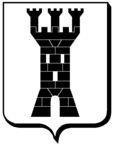Mars-la-Tour
| Mars-la-Tour | ||
|---|---|---|

|
|
|
| region | Grand Est | |
| Department | Meurthe-et-Moselle | |
| Arrondissement | Briey | |
| Canton | Jarny | |
| Community association | Mad et Moselle | |
| Coordinates | 49 ° 6 ' N , 5 ° 53' E | |
| height | 197-263 m | |
| surface | 12.64 km 2 | |
| Residents | 965 (January 1, 2017) | |
| Population density | 76 inhabitants / km 2 | |
| Post Code | 54800 | |
| INSEE code | 54353 | |
 War memorial in Mars-la-Tour |
||
Mars-la-Tour is a French commune with 965 inhabitants (as of January 1, 2017) in the Meurthe-et-Moselle department in the Grand Est region (until 2015 Lorraine ).
geography
Mars-la-Tour is located 20 kilometers west of Metz . From 1871 to 1919 Mars-la-Tour was a border town between Germany and France.
history
In Roman times, Mars-la-Tour was a Roman fort with a tower in honor of the god of war Mars , the name of the city is derived from this tower Mars-la-Tour - Tower of Mars .
In 1817 Mars-la-Tour was a village in the former province of Trois-Évêchés . At that time there were 1050 residents in 104 houses.
In August 1870, two battles took place near the city during the Franco-Prussian War . On August 16, 1870 the Battle of Mars-la-Tour and on August 18, 1870 the Battle of Gravelotte or the Battle of Sankt Privat .
On August 4, 1914, the 83rd French Infantry Brigade advanced on Mars-la-Tour, whose task it was to open the way to Metz in order to retake Lorraine.
Mars-la-Tour was again the scene of heavy fighting during the battle for Metz in 1944 . In September 1944 fighting broke out between the 3rd US Army under the command of Lieutenant General George S. Patton and the 462nd Training Division of General Walther Krause .
Population development
| year | 1962 | 1968 | 1975 | 1982 | 1990 | 1999 | 2006 | 2009 | 2014 |
| Residents | 790 | 841 | 787 | 765 | 823 | 854 | 937 | 962 | 966 |
These statistical values come from the database of the Institut national de la statistique et des études économiques
Attractions
- Remains of a Roman thermal bath
- Castle, first mentioned in 1192, later the seat of the Ficquelmont family . The current system consists of only two towers and the connecting building between these towers. The remaining complex was demolished by the owners in the 18th century
- Monument by the sculptor Frédéric Louis Désiré Bogino for the French fallen in the battles of Mars-la-Tour and Gravelotte in the Franco-Prussian War 1870/71, built with the support of the French President Marshal de Mac-Mahon in 1875. It represents a dying man Soldiers in the arms of an allegorical female figure. Two young children at their feet; one grabs the dying man's rifle, while the other leans on the anchor of hope and looks to the future. Under the memorial there is a crypt with the remains of 1,500 French soldiers who died.
- Statue of Joan of Arc from 1906
- Former military museum of Mars-la-Tour: The theme is the battles from 1870. The museum was founded by Pastor Joseph Faller. He collected drawings and memorabilia from fighters, relatives and friends from the war and wanted the museum to be a memorial against the war. It was opened on August 16, 1902 and the Bishop of Nancy and Toul blessed the place. After the First World War , the city lost the status of a pilgrimage city and tourists stayed away. The museum had to close. The exhibits can be seen today in the Military Museum in Gravelotte. The building is currently used as a daycare center.
Churches
- Parish Church of St. Martin: built in 1840, renovated and enlarged in the second half of the 19th century. It houses a chapel commemorating the battles of August 16 and 18, 1870. The organ dates from 1912 and was made by the Cavaillé-Coll family of organ builders .
- Chapel of St. Dominic ; there used to be a hospital with the same name, which is now a retirement home.
- Collégiale de Chanoines de L'Annonciation . The Canons was from 1500 to 1502 by Gérard d'Avillers built. During the French Revolution, the Canon Monastery passed into stately ownership.
Chapel of St. Dominic
Personalities
- Mars-la-Tour is one of the ancestral seats of the French noble family Ficquelmont
- Joseph Faller, pastor and founder of the military museum that bore his name
- On August 29, 1960, the German art and architecture historian Hanno Hahn , the only son of nuclear researcher and Nobel Prize winner Otto Hahn (1879–1968), died in Mars-la-Tour as a result of a car accident. His wife Ilse Hahn was brought to the nearby 'Clinique des Mines' in Briey with two cervical spine fractures , where she succumbed to serious injuries on September 7th.
Web links
- Website commemorating the victims of the battles of Mars-la-Tour in 1870
- Memorial stone for the fallen of Hannov. Field type reg. No. 10 & Torgauer Feldart.-Reg. No. 74 near Mars-la-Tour
- The trumpeter from Mars-la-Tour
- Der von Trawerz, parody by Robert Neumann [1]
Individual evidence
- ↑ René Caboz, La Bataille de Metz. 25 août - 15 septembre 1944 , Sarreguemines, 1984. (pp 153-176)
- ^ Official population of Mars-la-Tour
- ↑ Official population figures as of January 1, 2006
- ↑ Official population figures as of January 1, 2010
- ^ Free translation of the French Wikipedia article on the monument




